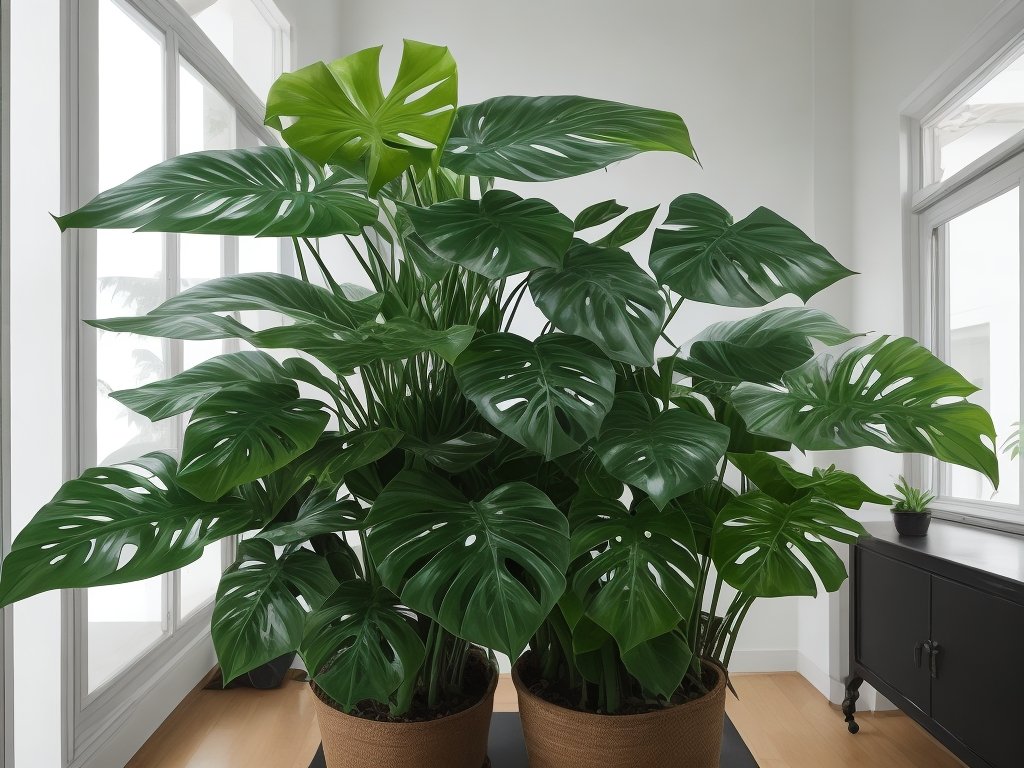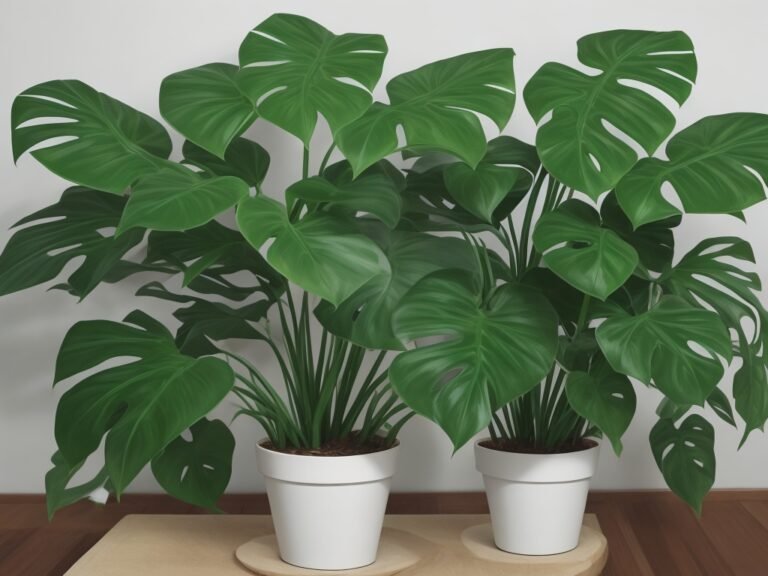How To Treat Root Rot In Monstera Plants?
Key Takeaways:
- Preventing root rot in Monstera plants is crucial for their overall health and longevity.
- Providing proper drainage and avoiding overwatering are essential in preventing root rot in Monstera plants.
- Fungicides can be used to treat root rot in Monstera plants, but prevention is always the best approach.
- Regularly inspecting and caring for the roots of Monstera plants can help catch and treat root rot early on.
Do you love your Monstera plant like it’s your own child?
Well, imagine your child getting sick and not knowing what to do.
That’s the same feeling I had when I discovered root rot in my beloved Monstera plant.
Root rot, a common issue among Monstera plants, can quickly turn your thriving green beauty into a withered mess.
But fear not! I’ve got your back.
In this article, I’ll guide you through the signs, causes, prevention methods, and step-by-step treatment of root rot.
So grab your gardening gloves and let’s get your Monstera back on the road to recovery!
| Treatment | Description |
|---|---|
| 1. Remove affected roots | Identify and remove any brown or mushy roots using sterile scissors or pruning shears. Make clean cuts above the rotted area. |
| 2. Improve drainage | Check the plant’s pot for proper drainage holes. Repot with a well-draining soil mix, or add materials like perlite or orchid bark to improve drainage. |
| 3. Adjust watering | Avoid overwatering by allowing the top inch of soil to dry out before watering. Water thoroughly but allow excess water to drain away. |
| 4. Ensure proper light | Place the Monstera plant in bright, indirect light. Avoid direct sunlight as it can burn the leaves and increase soil moisture. |
| 5. Apply fungicide | If the root rot is severe, seek professional advice and consider using a fungicide suitable for root rot treatment. Apply as directed. |
| 6. Observe for improvement | Monitor the plant closely for signs of recovery. Adjust care and treatment if necessary based on the plant’s response. |
What is root rot in Monstera plants?
Root rot in Monstera plants is a fungal disease that affects the roots, causing them to decay and become mushy, ultimately leading to plant wilting and death.
Definition of root rot
Root rot is a fungal disease that affects the roots of plants, including Monstera plants. It occurs when the roots become waterlogged, leading to a lack of oxygen and the growth of harmful fungi.
This can result in the roots becoming weak, mushy, and discolored, ultimately causing damage to the overall health of the plant.

Causes of root rot in Monstera plants
Root rot in Monstera plants is primarily caused by overwatering, which leads to excessive moisture in the soil and prevents proper oxygenation of the roots.
Other causes include poorly drained soil, using containers without drainage holes, and over-fertilization, which can result in salt buildup.
These factors create the ideal conditions for root rot-causing fungi to thrive.

How to identify root rot in Monstera plants?
To identify root rot in Monstera plants, look for visible signs such as wilting leaves, yellowing or browning leaves, and a foul odor.
You can also test for root rot by gently removing the plant from its pot and inspecting the roots for mushy or discolored sections.
Visible signs of root rot
Visible signs of root rot in Monstera plants include wilting leaves, yellowing or browning foliage, stunted growth, and a foul odor coming from the soil. The roots may appear brown, mushy, and slimy.
Testing for root rot in Monstera plants
To test for root rot in Monstera plants, carefully remove the plant from its pot. Examine the roots, looking for brown, slimy, or mushy roots.
Healthy roots should be firm and white.
Another test is to gently tug on the roots; if they easily detach from the plant, it may be a sign of root rot. Additionally, smelling the roots can indicate root rot as they may emit a foul odor.
If you suspect root rot, it’s best to act quickly to prevent further damage to your Monstera plant.
Prevention methods for root rot in Monstera plants
To prevent root rot in Monstera plants, focus on proper watering techniques, soil and pot selection, ensuring proper drainage, and avoiding over-fertilization.
Proper watering techniques
Proper watering techniques for Monstera plants are essential for preventing root rot. Here are some tips:
- Water your plant only when the top inch of soil is dry.
- Use a well-draining soil mix to ensure excess water can escape.
- Water thoroughly but avoid overwatering, as this can suffocate the roots.
- Allow any excess water to drain out from the pot.
- Avoid leaving the plant sitting in water for extended periods.
- Adjust your watering schedule according to the season and humidity levels.
Remember, finding the right balance is key to keeping your Monstera plant healthy and free from root rot.

Soil and pot selection
The right soil and pot selection is crucial for preventing root rot in Monstera plants.
Choose well-draining soil that allows water to flow through easily, such as a mixture of peat moss, perlite, and coarse sand.
Opt for a pot with drainage holes to prevent water from pooling at the bottom.
Avoid using pots that are too big, as excess soil can hold too much moisture.
Ensuring proper drainage
To ensure proper drainage for your Monstera plant, use a well-draining potting mix that consists of a combination of peat moss, perlite, and compost. Make sure the pot has drainage holes so excess water can escape.
Avoid overwatering and allow the soil to dry out slightly between waterings.

Avoiding over-fertilization
To avoid over-fertilization in your Monstera plants, it’s important to follow these guidelines:
- Use a well-balanced fertilizer: Choose a fertilizer specifically formulated for houseplants and follow the instructions on the package for the correct dosage.
- Don’t exceed the recommended frequency: Over-fertilizing can lead to an excess buildup of nutrients in the soil, which can harm the roots. Stick to the recommended schedule for fertilizing your Monstera plant.
- Dilute the fertilizer: If you’re unsure about the strength of your fertilizer, it’s better to err on the side of caution and dilute it with water before applying it to your plant. This will help prevent over-concentration of nutrients.
- Monitor your plant’s response: Pay attention to how your Monstera plant reacts after fertilizing. If you notice any signs of nutrient burn, such as brown or yellowing leaves, reduce the frequency or strength of your fertilizer.
Remember, moderation is key when it comes to fertilizing your Monstera plants.
Stick to the recommended guidelines and keep a close eye on your plant’s health to avoid over-fertilization.
Treating root rot in Monstera plants
To treat root rot in Monstera plants, focus on removing affected roots, cleaning the pot and soil, and repotting the plant.
Step-by-step guide to treating root rot
To treat root rot in Monstera plants, start by removing affected roots. Then, clean and disinfect the pot and soil.
Repot the plant in fresh, well-draining soil.
Adjust watering habits, monitor plant health, provide proper lighting and temperature conditions, and fertilize as needed.
Removing affected roots
To remove affected roots from your Monstera plant, you’ll need a clean pair of sharp scissors or garden shears.
Carefully inspect the roots for any signs of discoloration, mushiness, or foul odor.
Gently cut away the affected roots, making clean cuts to prevent any further damage.
Be sure to dispose of the removed roots properly to avoid spreading any potential infection.
Cleaning and disinfecting the pot and soil
To clean and disinfect the pot and soil of your Monstera plant, you can follow these steps:
- Remove the plant from the pot: Gently take the plant out of the pot, being careful not to damage the roots.
- Inspect the roots: Check for any signs of root rot, such as mushy or discolored roots. Trim away any affected roots using clean, sterilized scissors or pruners.
- Clean the pot: Thoroughly wash the pot with soap and warm water to remove any dirt or debris. Rinse it well to ensure all soap residue is gone.
- Disinfect the pot: Use a solution of one part bleach to nine parts water to disinfect the pot. Allow the pot to soak in the solution for about 10 minutes, then rinse it thoroughly with clean water.
- Clean the soil: Remove as much of the old soil as possible without damaging the roots. You can gently rinse the roots under running water to help remove any remaining soil.
- Replace the soil: Fill the pot with fresh, well-draining soil suitable for Monstera plants. Make sure to leave enough space for the plant’s roots and ensure the soil is not compacted.
- Repot the plant: Carefully place the Monstera plant back into the pot, ensuring that the roots are positioned properly. Gently press the soil around the roots to secure the plant in place.
By cleaning and disinfecting the pot and soil, you can help eliminate any potential pathogens or contaminants that may cause or contribute to root rot.
It’s an important step in treating and preventing root rot in Monstera plants.
Repotting the Monstera plant
To repot a Monstera plant, start by gently removing it from its current pot and loosening the root ball.
Inspect the roots for signs of rot and trim away any affected sections.
Then, clean and disinfect the pot and choose a new one that is slightly larger.
Fill the new pot with well-draining soil and place the plant inside, making sure it is centered.
Add more soil around the roots and gently press it down.
Finally, water the plant thoroughly and place it in a suitable location with adequate light and temperature conditions.
Caring for Monstera plants after treating root rot
After treating root rot in your Monstera plant, it is important to adjust your watering habits, monitor plant health, provide proper light and temperature conditions, and fertilize and maintain plant nutrition.
Adjusting watering habits
To adjust watering habits for Monstera plants after treating root rot, it’s important to find the right balance.
Here’s how:
- Allow the soil to dry out partially before watering again.
- Use the “finger test” to check soil moisture. Stick your finger into the soil up to the knuckle – if it feels dry, you can water.
- Avoid overwatering, as this can lead to new root rot issues.
- Adjust watering frequency based on environmental conditions such as humidity and temperature.
- Consider using a well-draining potting mix and a pot with drainage holes to prevent waterlogging.
Monitoring plant health
To monitor the health of your Monstera plant, keep an eye out for visible signs of distress such as yellowing or wilting leaves, stunted growth, or root discoloration.
Regularly check the soil moisture levels by sticking your finger about an inch into the soil.
If it feels dry, it’s time to water.
Lastly, observe the overall appearance of the plant, looking for any abnormalities or changes in its usual behavior.
Providing proper light and temperature conditions
Proper light and temperature conditions are essential for the health of your Monstera plant.
Place it in bright, indirect light, as direct sunlight can scorch its leaves.
Aim for a temperature range of 65-85°F (18-29°C).
Avoid extreme temperature fluctuations and drafty areas.
Fertilizing and maintaining plant nutrition
To fertilize and maintain the nutrition of your Monstera plant, you need to provide it with the right balance of nutrients. Use a balanced fertilizer specifically formulated for houseplants, and follow the instructions on the packaging for dosage and frequency.
Additionally, ensure that the soil is well-draining and replenish nutrients by repotting with fresh soil every 1-2 years.
Lastly, monitor the plant’s health and adjust the fertilization schedule as needed. Remember, balanced nutrition is essential for the overall well-being of your Monstera plant.
Frequently Asked Questions about treating root rot in Monstera plants
How often should I water my Monstera plant to prevent root rot?
To prevent root rot in your Monstera plant, it’s essential to water it correctly. Allow the top inch of the soil to dry out between waterings.
Stick your finger into the soil to check if it feels dry.
Water thoroughly but avoid overwatering or leaving the plant sitting in waterlogged soil. Remember, it’s better to underwater than overwater!
Can I save a Monstera plant with severe root rot?
Yes, it is possible to save a Monstera plant with severe root rot.
The key is to act quickly and take the necessary steps to address the issue.
This includes removing affected roots, cleaning and disinfecting the pot and soil, and repotting the plant with fresh soil.
After treatment, adjust watering habits, monitor plant health, and provide the proper care conditions to promote recovery.
Can I use natural remedies to treat root rot in Monstera plants?
Yes, you can use natural remedies to treat root rot in Monstera plants.
Some effective options include:
- Neem oil: Dilute neem oil with water and apply it to the affected plant roots. Neem oil has antifungal properties that can help combat root rot.
- Cinnamon: Sprinkle cinnamon powder on the affected roots. Cinnamon has natural antifungal properties that can inhibit the growth of root rot pathogens.
- Hydrogen peroxide: Mix a solution of 3% hydrogen peroxide and water, then water the plant with it. This can help oxygenate the root system and kill off harmful bacteria.
- Aloe vera: Apply aloe vera gel to the affected roots to help promote root healing and boost the plant’s immune system.
Remember, natural remedies can be effective in treating root rot, but it’s also important to address the underlying causes and practice proper plant care to prevent future occurrences.
Final Verdict
Treating root rot in Monstera plants requires timely identification, prevention, and effective treatment methods.
By practicing proper watering techniques, selecting the right soil and pot, ensuring proper drainage, and avoiding over-fertilization, you can prevent root rot from occurring.
If root rot does occur, it is important to carefully remove affected roots, clean and disinfect the pot and soil, and repot the plant.
After treatment, adjusting watering habits, monitoring plant health, providing proper light and temperature conditions, and maintaining plant nutrition will help ensure the Monstera plant’s recovery and long-term health.
With these practices in place, you can successfully treat root rot and enjoy thriving Monstera plants in your home.





